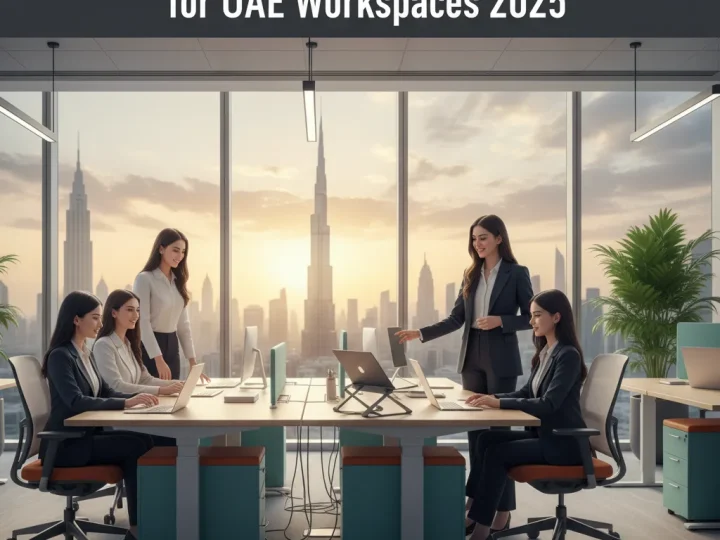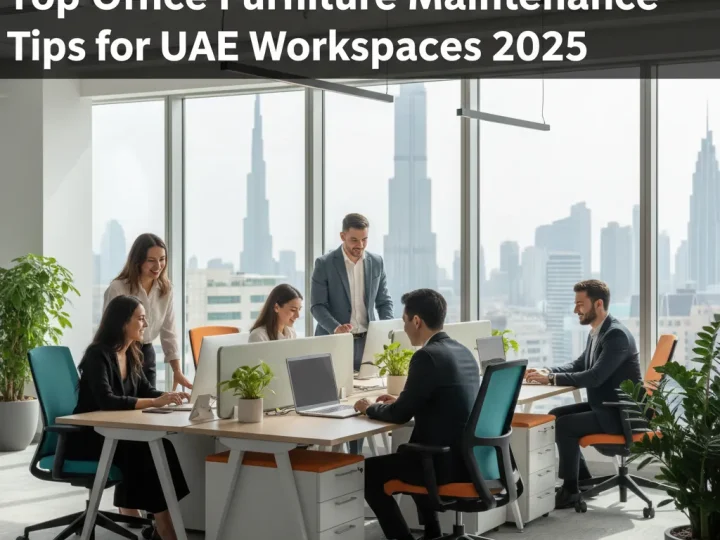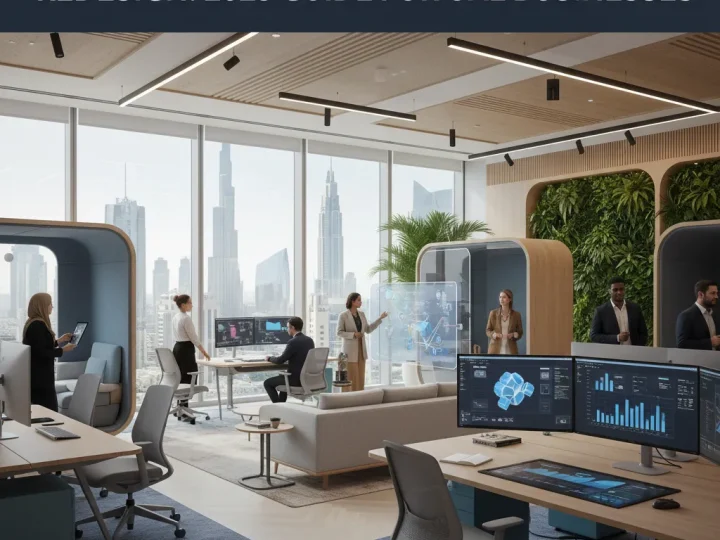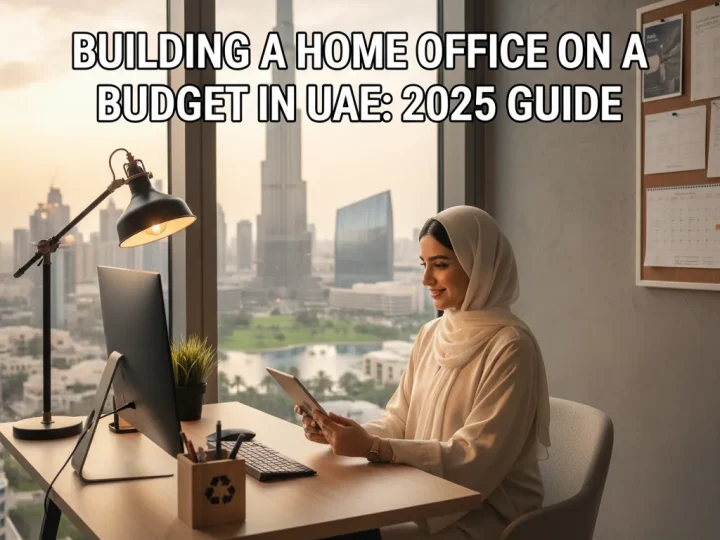
Office space in Dubai is at a premium and efficient layouts can make or break productivity. Think about this. Up to 30 percent of typical office space is left unused during working hours yet companies keep paying for every square foot. Instead of cramming in more desks or costly expansions the biggest wins often come from re-imagining what you already have. Surprising solutions like smart furniture, technology-driven layouts, and minimalist designs can completely transform your team’s daily experience.
Table of Contents
- Assessing Your Current Office Layout
- Smart Furniture And Storage Solutions
- Space-Saving Design Tips For UAE Offices
- Incorporating Technology For Flexible Workspaces
Quick Summary
| Takeaway | Explanation |
|---|---|
| Assess workspace layout for efficiency | Conduct a detailed analysis of your current office layout to identify areas for improvement and optimization. |
| Incorporate multifunctional furniture | Select furniture that serves multiple purposes to save space while enhancing productivity and flexibility. |
| Embrace technology in space management | Utilize smart technologies like occupancy sensors and booking platforms to optimize workspace utilization and adapt to changing needs. |
| Implement minimalist design principles | Use minimalist strategies such as vertical storage and open floor plans to create a sense of space while maintaining functionality. |
| Evaluate environmental factors | Assess acoustic quality, temperature control, and natural light in your office as these elements greatly influence employee productivity and comfort. |
Assessing Your Current Office Layout
Maximizing office space begins with a comprehensive assessment of your current workspace configuration. This critical first step determines how effectively you can transform your existing environment into a more efficient and productive area. Understanding the nuances of your current layout will help you identify opportunities for optimization and strategic space management.
Evaluating Workspace Density and Utilization
Workspace density plays a crucial role in employee satisfaction and productivity. Research published in the Buildings journal reveals that personal space area directly impacts visual and acoustic privacy, as well as employees’ positive self-perception. When assessing your office layout, carefully analyze the current workstation arrangement and spacing.
Key considerations include:
- Workstation Spacing: Measure the distance between individual work areas
- Occupancy Rates: Track how frequently different spaces are actually used
- Traffic Flow: Observe how employees move through the office environment
By conducting a detailed spatial analysis, you can identify underutilized areas and potential opportunities for reconfiguration. Some offices discover that up to 30% of their existing space remains unused during typical working hours, presenting significant optimization potential.
Environmental Factors Impacting Office Efficiency

A comprehensive review in Property Management highlights that environmental factors significantly influence employee concentration and productivity. When assessing your office layout, consider more than just physical space allocation.
Critical environmental elements to evaluate include:
- Acoustic Quality: Noise levels and sound management
- Temperature Regulation: Consistent and comfortable climate control
- Natural Light Exposure: Distribution of natural and artificial lighting
- Air Quality: Ventilation and overall workspace atmosphere
These factors contribute substantially to workspace effectiveness. An office that addresses environmental comfort can see productivity improvements of up to 15%, making them crucial considerations in your space maximization strategy.
Strategic Space Allocation Assessment
According to research from the Norwegian University of Science and Technology, office allocation significantly impacts staff satisfaction. Different employee roles and hierarchical levels require varied workspace configurations.
Consider these strategic allocation approaches:
- Individual vs. Shared Spaces: Balance private offices with collaborative areas
- Meeting Room Efficiency: Optimize meeting space usage and configuration
- Flexible Work Zones: Create adaptable areas that support multiple work styles
For businesses looking to dive deeper into modern office design, check out our comprehensive guide on innovative workspace solutions.
By systematically assessing your current office layout through these multifaceted lenses, you can develop a strategic approach to space maximization that enhances both operational efficiency and employee satisfaction.
To help you quickly compare the strategic allocation approaches mentioned, here’s a table summarizing key features and benefits:
| Approach | Key Features | Benefits |
|---|---|---|
| Individual vs. Shared Spaces | Mix of private offices and collaborative areas | Balances privacy and teamwork |
| Meeting Room Efficiency | Optimized use/configuration of meeting rooms | Reduces wasted space, increases availability |
| Flexible Work Zones | Adaptable areas for multiple work styles | Supports changing team needs |
Smart Furniture and Storage Solutions
Smart furniture and storage solutions represent a revolutionary approach to maximizing office space in modern workplaces. These innovative designs go beyond traditional furniture by integrating functionality, flexibility, and technological intelligence to create more efficient and adaptable work environments.
Multifunctional Furniture Design
Research from the National Institutes of Health highlights the critical role of flexible furniture in enhancing spatial efficiency and employee well-being. Modern smart furniture solutions are designed to serve multiple purposes, dramatically reducing the overall space requirements while increasing workplace productivity.
Key multifunctional furniture strategies include:
- Convertible Workstations: Desks that transform from sitting to standing positions
- Modular Seating: Chairs and sofas that can be easily reconfigured for different meeting formats
- Hidden Storage Solutions: Furniture with integrated storage compartments that minimize clutter
These designs allow businesses to create more dynamic and adaptable workspaces without sacrificing comfort or functionality. For instance, a single conference room can now accommodate various meeting styles and team configurations through intelligent furniture choices.
Technology-Integrated Storage Systems
Advanced storage solutions now incorporate smart technologies that maximize space utilization and improve workplace efficiency. Vertical storage systems with automated retrieval mechanisms can significantly reduce the physical footprint of traditional storage areas.
Innovative storage technologies include:
- Digital Inventory Management: Smart shelving with RFID tracking
- Compact Mobile Shelving: Electronically controlled units that compress unused space
- Cloud-Connected Storage: Systems that integrate digital and physical document management
Explore our latest innovations in office furniture design to understand how technology is transforming workplace storage solutions.
Ergonomic and Space-Efficient Furniture Selection
Selecting the right furniture goes beyond aesthetic considerations. The most effective space-maximizing solutions combine ergonomic design with compact functionality. Look for furniture that:
- Supports multiple working postures
- Provides built-in cable management
- Offers adjustable configurations
- Minimizes individual footprint while maximizing usable workspace
Ergonomic furniture not only saves space but also contributes to employee health and productivity. Chairs with integrated storage, desks with fold-away components, and collaborative furniture that can be easily reconfigured represent the future of office design.
Implementing smart furniture and storage solutions requires a strategic approach. By carefully selecting multifunctional, technology-integrated pieces, businesses can create more efficient workspaces that adapt to changing needs while maximizing every square meter of available office space.
The following table provides a quick comparison of smart furniture and storage solutions discussed above:
| Solution Type | Key Features | Benefits |
|---|---|---|
| Convertible Workstations | Switch between sitting/standing, adjustable | Enhances comfort, saves space |
| Modular Seating | Reconfigurable, supports varied formats | Flexibility for meetings/collaboration |
| Hidden Storage | Integrated compartments, reduces clutter | Maximizes usable area, improves aesthetics |
| Digital Inventory Mgmt | RFID tracking, smart shelving | Efficient storage, quick retrieval |
| Compact Mobile Shelving | Electronically compresses unused space | Saves floor space, scalable |
| Cloud-Connected Storage | Integrates digital/physical doc management | Reduces paper, streamlines workflow |
Space-Saving Design Tips for UAE Offices
Effective space management is crucial for businesses in the UAE, where real estate costs are high and office space is often at a premium. Implementing strategic design approaches can transform limited square footage into highly functional and efficient work environments.
Minimalist Layout Strategies
Research published in Environment and Behavior demonstrates that thoughtful office design significantly influences knowledge work productivity and collaboration. Minimalist design principles offer an innovative approach to maximizing spatial efficiency.
Key minimalist strategies include:
- Vertical Space Utilization: Implement floor-to-ceiling shelving and wall-mounted storage systems
- Reduced Furniture Footprint: Choose slim, compact furniture designs
- Open Floor Plans: Create adaptable spaces that can be easily reconfigured
By adopting a minimalist approach, offices can create an illusion of spaciousness while maintaining functional workspace requirements. The goal is to eliminate unnecessary visual clutter and optimize every square meter.
Collaborative Design Configurations
A study in the Facilities journal highlights the effectiveness of combi-office designs that balance collaboration and privacy. In the UAE context, this means creating flexible spaces that can adapt to different work styles and team dynamics.
Effective collaborative design approaches include:
- Movable Partition Systems: Lightweight, easily adjustable room dividers
- Hot-Desking Zones: Shared workspaces that maximize occupancy
- Multipurpose Meeting Areas: Spaces that serve multiple functions throughout the day
These configurations allow businesses to create dynamic environments that can quickly transform to meet changing workplace needs.
Sustainable Space Optimization
Research published in Buildings journal emphasizes how office design can support organizational sustainability by minimizing storage areas and standardizing spaces. For UAE offices, this translates to strategic space management that reduces unnecessary square footage.
Sustainable space-saving techniques include:
- Digital Document Management: Reducing physical storage requirements
- Standardized Workstation Designs: Creating uniform, efficient workspace layouts
- Integrated Technology Solutions: Implementing smart systems that reduce physical infrastructure
For businesses looking to dive deeper into cost-effective office design, check out our comprehensive furniture buying guide for additional insights.
Implementing these space-saving design tips requires a holistic approach that considers functionality, flexibility, and the unique characteristics of UAE office environments. By carefully selecting design strategies that maximize efficiency, businesses can create workspaces that are both visually appealing and highly productive.
Incorporating Technology for Flexible Workspaces
Technology has become a transformative force in modern office design, enabling businesses to create more adaptive, efficient, and intelligent workspaces. By integrating smart digital solutions, organizations can maximize space utilization, enhance employee productivity, and create more dynamic work environments.
Smart Space Management Technologies
According to the Harvard Business Review, workspace technologies such as booking apps, digital collaboration tools, and occupancy sensors are revolutionizing how businesses approach office layout and utilization. These intelligent systems provide real-time insights into workspace usage, allowing for data-driven decisions about spatial configurations.
Key technological solutions for space management include:
- Occupancy Sensor Systems: Track real-time workspace usage
- Digital Booking Platforms: Enable flexible desk and meeting room reservations
- Heat Mapping Software: Visualize workspace utilization patterns
These technologies allow businesses to understand precisely how office spaces are used, identifying underutilized areas and optimizing layout strategies.
Adaptive Digital Infrastructure
The National Academies of Sciences, Engineering, and Medicine report highlights how digital systems enable more flexible workspace allocation. Smart building technologies can dynamically adjust environmental conditions, reducing real estate overhead and promoting efficient space utilization.
Advanced digital infrastructure capabilities include:
- IoT-Enabled Climate Control: Automatically adjust temperature and lighting based on occupancy
- Wireless Connectivity Zones: Create flexible work areas with seamless technological integration
- Cloud-Based Collaboration Platforms: Support remote and hybrid working models
For businesses seeking to stay ahead of technological workplace trends, explore our guide to contemporary office innovations.
Integration of Artificial Intelligence
Artificial Intelligence (AI) is emerging as a powerful tool for workspace optimization. AI-driven systems can predict workspace needs, recommend layout modifications, and create more responsive office environments.
Potential AI applications in workspace management include:
- Predictive Space Planning: Using machine learning to forecast workspace requirements
- Automated Resource Allocation: Dynamically assign workspaces based on team needs
- Personalized Environment Controls: Adapt workspace settings to individual preferences

By strategically incorporating these technological solutions, businesses can transform traditional office spaces into intelligent, flexible environments that adapt to changing workforce dynamics. The key is to view technology not just as a tool, but as an integral component of workspace design that enhances productivity, collaboration, and employee satisfaction.
Frequently Asked Questions
What are some effective ways to maximize office space in Dubai?
To maximize office space in Dubai, consider assessing your current layout, incorporating multifunctional furniture, utilizing smart technologies for space management, and adopting minimalist design principles.
How can technology help in optimizing office space?
Technology can optimize office space by using smart space management systems, occupancy sensors, digital booking platforms, and AI-driven solutions to track usage patterns and reallocate resources effectively.
What role do environmental factors play in office efficiency?
Environmental factors such as acoustic quality, temperature control, natural light exposure, and air quality significantly impact employee productivity and comfort, making them crucial when designing a functional office space.
What is the importance of ergonomic furniture in a workspace?
Ergonomic furniture is essential as it supports health and comfort, enhances productivity, and can help maximize space efficiency by combining design with functionality, ensuring that every area is utilized effectively.
Unlock the True Potential of Your Dubai Office Space
Struggling with underused office areas, cluttered layouts, or wasted square footage? The challenges highlighted in our guide—ranging from inefficient space use and the need for smart furniture to demands for advanced technology—are daily realities for many Dubai businesses. Falling behind on workspace optimization can mean lost productivity and increased costs, especially in a competitive 2025 landscape. At SAGTCO, we understand the urgency of transforming office efficiency and bringing your vision for a modern, effective workspace to life.

Experience how SAGTCO’s tailored solutions turn theory into reality. Our expert consultation services cover free space planning, custom furniture design, and the latest in office technology—delivering the strategic edge your company needs. Discover how you can move from ideas to action by visiting our Contact Page. Reach out today and let us help you create a workplace where every meter counts. Now is the perfect time to reimagine your space and achieve the productivity and aesthetics you truly deserve.
Recommended
- Modern Office Design DUBAI: Inspiring Workspace Trends – Office Furniture Dubai | Buy Modern Office Furniture Dubai – SAGTCO
- 2025 Office Furniture Budget Tips: Smart Savings Guide – Office Furniture Dubai | Buy Modern Office Furniture Dubai – SAGTCO
- How to Set Up a Professional Office Without Breaking the Bank? – Office Furniture Dubai | Buy Modern Office Furniture Dubai – SAGTCO
- Office Furniture Stores in Dubai: Transform Your Workspace Today
Comments (0)
Leave a reply
You must be logged in to post a comment.




